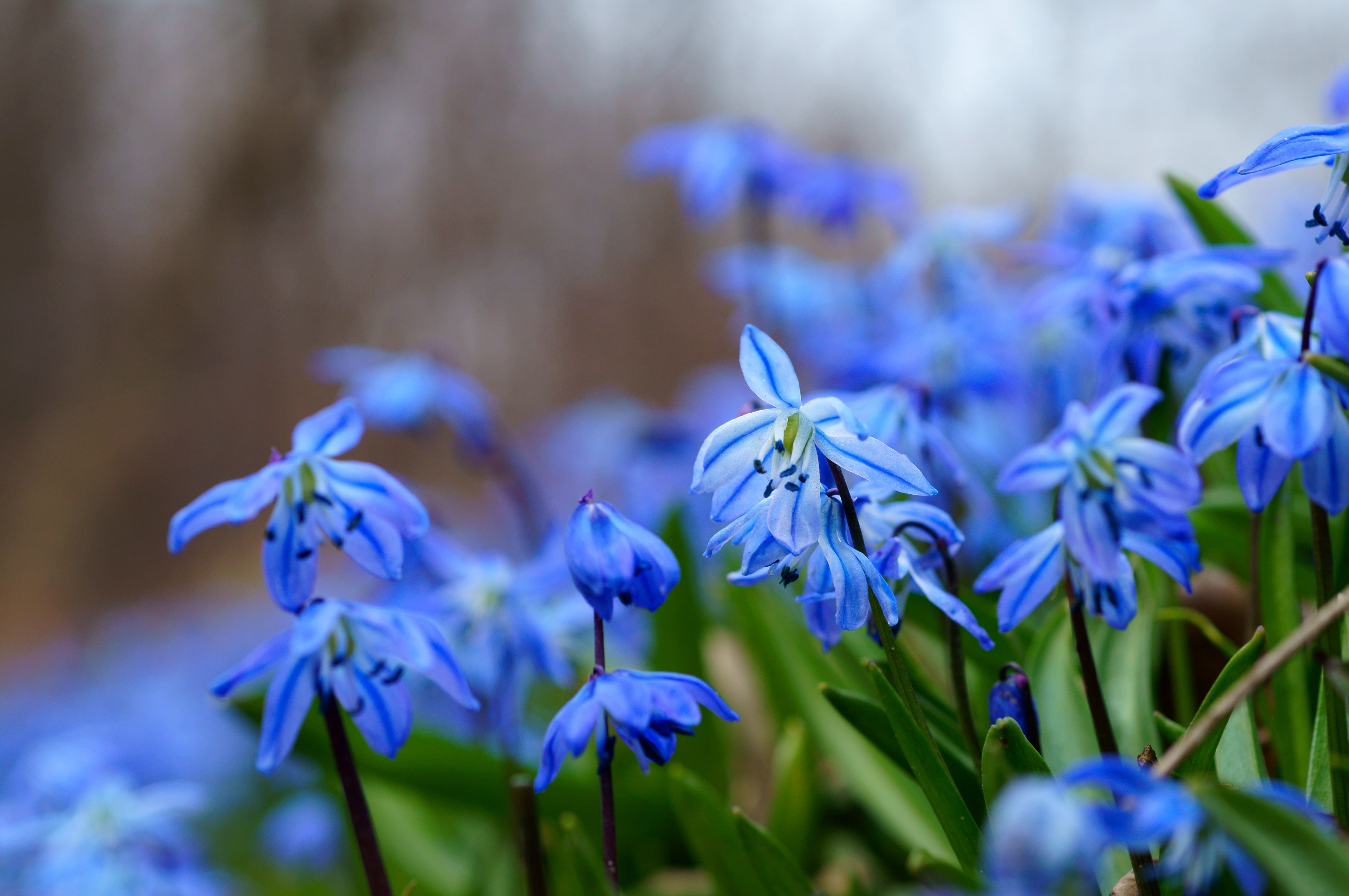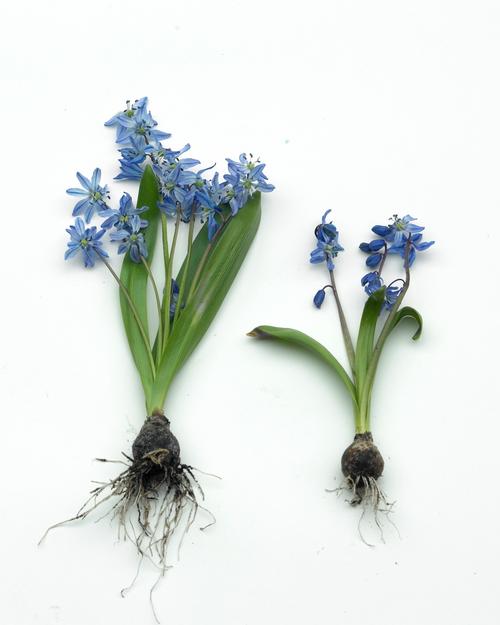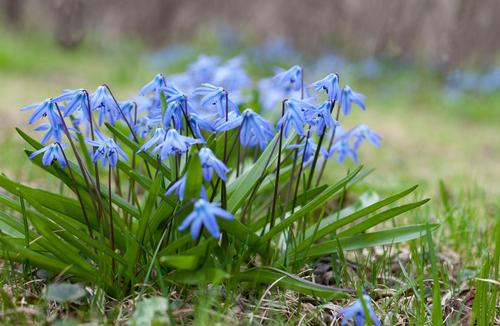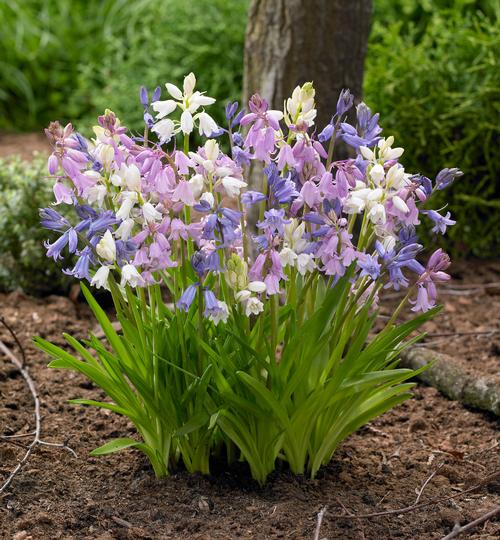Your Guide to Planning, Planting, and Growing Scilla
The scilla family of spring-blooming bulbs includes some of the best bulbs for naturalizing. When planted beneath shrubs and shade trees, in woodlands and beside streams and ponds, they will multiply quickly and bloom in waves of color year after year.
Siberian squill (S. siberica) and wood hyacinths (S. campanulata) are two of the most popular types of scilla. Quick to plant and untroubled by rodents or deer, they are an easy way to add a new dimension of spring beauty to your gardens and landscape.

Start with a Better Bulb
When you compare two scilla bulbs side by side, it’s easy to see differences in quality. Larger bulbs (as shown on the far left) contain more stored food energy and can support a stronger plant and more abundant flowers. Longfield Gardens supplies 7/8cm Siberian squill bulbs and 6/7cm wood hyacinth bulbs so you can enjoy the biggest, brightest blooms.

Plan for Success
Sun or Shade: Scilla should be grown in full sun or partial shade. They will not flower in deep shade.
Hardiness Zone: Scilla are winter hardy in zones 4-8. Find your growing zone here.
Soil Conditions: Scilla siberica and Scilla campanulata are not fussy about soil, but perform best when it is well drained and fertile.

Where to Plant Scilla
Scillas are good companions for other early spring bulbs such as crocus, snowdrops, chionodoxa and daffodils. Plant them in places where you'll be happy to have them multiply over time.
Scilla siberica: Commonly known as Siberian squill or spring beauty, these bulbs send up multiple stems topped with dainty blue flowers that resemble little parasols. The cobalt blue blossoms provide one of nature's purest blues. At just 4” tall, they make their impact with quantity, not size. Scilla siberica blooms early and the foliage fades away quickly after flowering. This makes them a good choice for planting beneath shrubs, around the base of trees or even right in the lawn.
Shop for Scilla siberica HERE.
Scilla campanulata: These spring-blooming bulbs are commonly known as wood hyacinths or Spanish bluebells. They may also go by the name Hyacinthoides hispanica. The flowers resemble the fragrant wild bluebells (Hyacinthoides non-scripta) that carpet woodlands in England.
Though Scilla campanulata is a close relative of Scilla siberica, its foliage and flowers are considerably larger. Scilla campanulata has strappy foliage and bell-shaped flowers that are loosely clustered around a 12-15" tall stem. The pastel-colored blossoms come in lavender, pink and white. Scilla campanulata blooms in late spring and is a good naturalizer for woodlands and meadows.
Shop for Scilla campanulata HERE.

How to Plant Scilla
When to Plant: Scilla bulbs should be planted in mid to late fall, any time after the first frost and before the ground freezes. For best results, plant the bulbs within a month after you receive them.
Depth and Spacing: Plant scilla bulbs 3 to 4” deep and 3 to 4” apart on center.
Planting Tips: The bulbs of scilla siberica and scilla campanulata don't need to be planted very deeply, so it's easy to plant lots of bulbs in just a few minutes. For the most natural look, plant the bulbs in irregular clusters of 10 with no more than a couple inches between each bulb.

What to Expect
Scilla bulbs are planted during the fall so they can grow roots before winter. The bulbs sprout in early spring and are in bloom just a couple weeks later.
Scilla bulbs multiply in two ways: by seed and by bulb offsets. The seeds are often transported by ants, which is why you'll discover the flowers blooming in expected places. Over time, a few handfuls of bulbs can become a carpet of beautiful blooms.
If your garden is plagued by rabbits, chipmunks, voles or deer, you'll be happy to know that these pests usually ignore scilla bulbs and flowers.

Caring for Scilla after they Flower
Bulbs use their foliage to generate energy for next year’s blooms. After the blossoms fade, it is important to let the foliage continue growing until it has lost its green color and melts away. Once the foliage is gone, the bulbs will be dormant underground until they start growing again the following spring.
The foliage of scilla siberica usually matures and fades away within a couple weeks. The foliage of scilla campanulata may take a month or more to mature. Ferns, astilbes or hostas can be used to help to hide the slowly withering leaves.
If you want to learn more about scilla and other early spring flowers, you may be interested in:
Earliest Bulbs for Spring Gardens
Hurry Spring With Early-Blooming Bulbs
How to Naturalize Spring-Blooming Bulbs
How to Plan a Spring Bulb Garden


